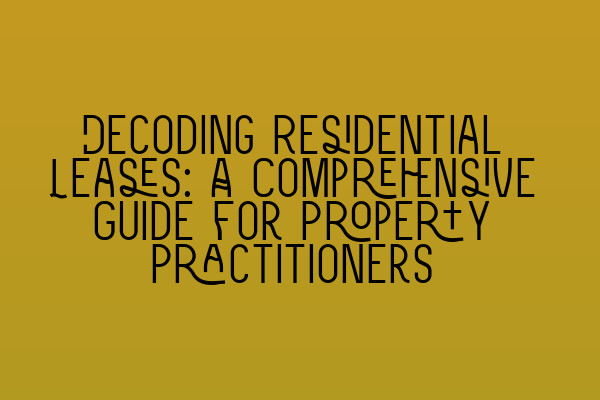Decoding Residential Leases: A Comprehensive Guide for Property Practitioners
As property practitioners, it is crucial to have a solid understanding of residential leases. Residential leases play a significant role in the property market, and knowing how to decode them can greatly benefit both you and your clients. In this comprehensive guide, we will break down the essentials of residential leases, helping you navigate through the intricacies of lease agreements.
What is a Residential Lease?
A residential lease is a legally binding contract between a landlord and a tenant, outlining the terms and conditions of renting a property. It specifies important details such as the duration of the lease, rental amounts, responsibilities of both the landlord and tenant, and any additional clauses that may apply.
Understanding the key components of a residential lease is crucial for property practitioners to ensure proper compliance and protect the interests of their clients.
The Essential Elements of a Residential Lease
1. Parties Involved: Every residential lease involves two parties: the landlord (property owner) and the tenant (person renting the property). It is essential to clearly identify both parties to avoid any confusion later on.
2. Property Description: The lease agreement should include a detailed description of the property being rented out, including its address and any other relevant details to ensure clarity.
3. Duration of the Lease: The lease agreement must specify the duration for which the property is being rented, including the start and end dates. Additionally, any terms regarding renewal or termination of the lease should be clearly stated.
4. Rent and Payment Terms: The rental amount, due date, and acceptable payment methods need to be clearly outlined in the lease. It is crucial to specify any consequences for late payment or failure to pay rent.
5. Deposit and Security: Most residential leases require tenants to provide a security deposit as a measure to cover any damages or unpaid rent. The lease agreement should detail the amount of the deposit, the conditions for its return, and any allowable deductions.
Understanding Lease Clauses
Residential leases often contain additional clauses that address specific aspects of the tenancy. It is important to understand these clauses to ensure compliance and avoid any legal issues. Here are a few common clauses found in residential leases:
1. Maintenance and Repair
This clause outlines the responsibilities of both the landlord and the tenant regarding property maintenance and repairs. It specifies who is responsible for general maintenance, such as cleaning, lawn care, and minor repairs, and also addresses major repairs and the process for reporting and resolving issues.
2. Pets and Smoking
Some leases have clauses that regulate whether tenants are allowed to have pets or smoke within the property. These clauses outline any restrictions, such as the types of pets allowed, size limitations, and specific smoking areas if permitted.
3. Subletting and Assignment
In some cases, tenants may wish to sublet the property or assign the lease to another person. This clause establishes guidelines for subletting and assignment, including the landlord’s consent requirements, any additional fees, and the tenant’s responsibilities in finding a suitable replacement.
4. Termination and Break Clauses
Termination and break clauses specify the conditions under which either the landlord or the tenant can end the lease agreement before its agreed-upon expiration date. These clauses outline the notice period required, any penalties or fees applicable, and the procedures for vacating the property.
The Importance of Reviewing and Drafting Leases
Reviewing and drafting residential leases is an integral part of the property practitioner’s role. Poorly crafted leases can lead to misunderstandings, disputes, and legal complications down the line. By ensuring that residential leases are comprehensive, fair, and legally sound, property practitioners can minimize risks and protect their clients.
To maximize the effectiveness of your lease agreements, it is crucial to stay up-to-date with the latest legal developments and industry best practices. Continuous professional development through courses, such as SQE 1 and SQE 2 Preparation Courses, can deepen your knowledge and enhance your skills as a property practitioner.
Conclusion
Decoding residential leases is an essential skill for property practitioners. By understanding the key components, clauses, and obligations laid out in these agreements, practitioners can provide expert guidance to their clients while safeguarding their interests. Continuous education and staying informed about legal updates through resources like SQE 1 Practice Exam Questions and SQE 1 Practice Mocks FLK1 FLK2 are vital for property practitioners to excel in their field. Remember, a well-crafted and thorough residential lease is the foundation for a successful landlord-tenant relationship.
